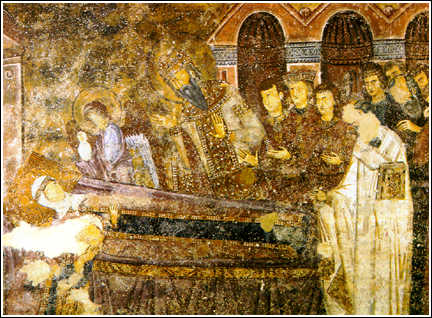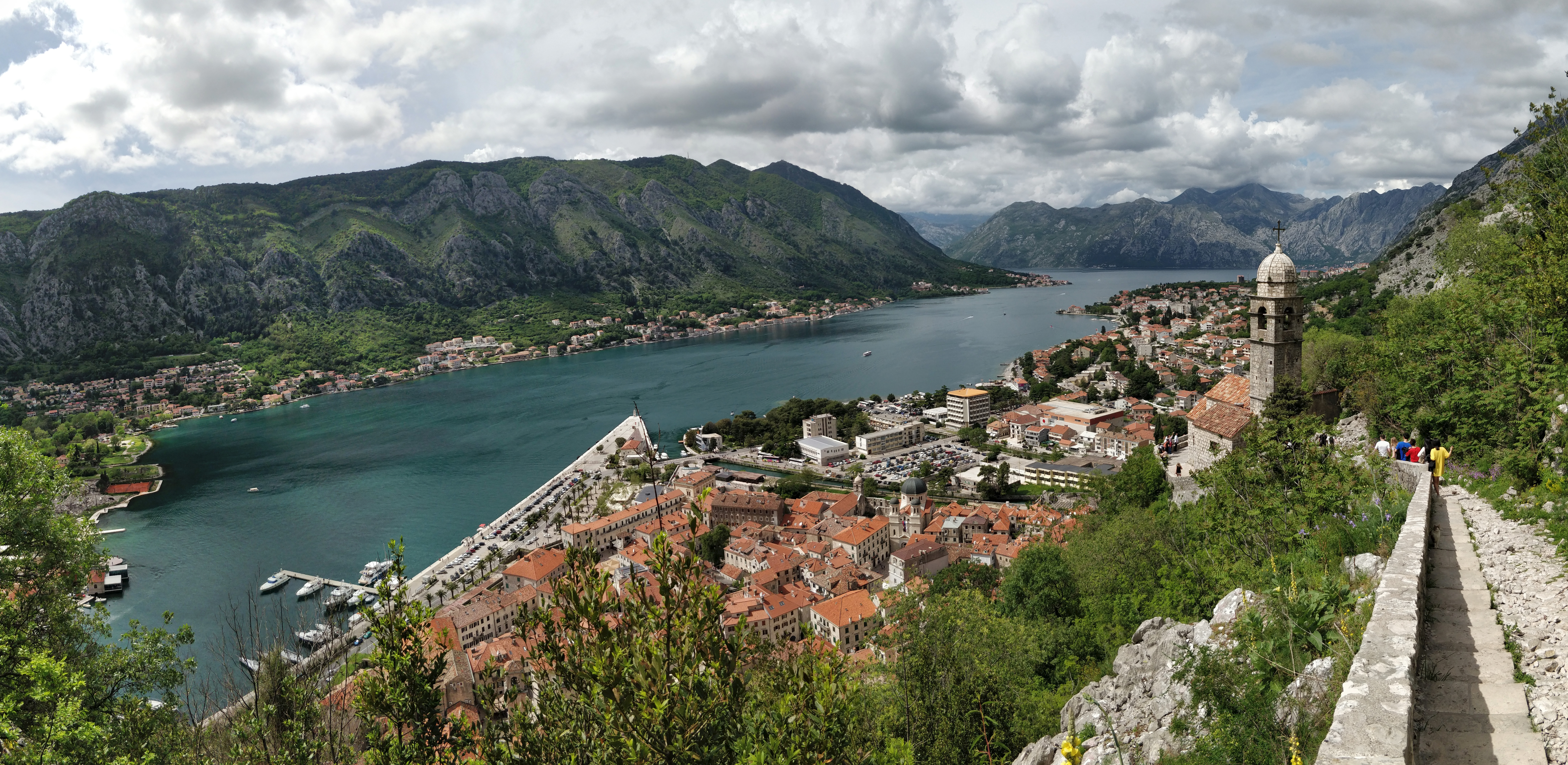|
Anna Angelina Komnene Doukaina
Anna Angelina Komnene Doukaina ( el, Ἄννα Ἀγγελίνα Κομνηνή Δούκαινα, sr-cyr, Ана Анђелина Комнина Дукина) was a daughter of Theodore Komnenos Doukas and Maria Petraliphaina. Anna was Queen-consort of Serbia as wife of King Stefan Radoslav. In 1216, Radoslav's father attempted to organize a marriage between his son and Theodora, daughter of Theodore's half-brother Michael Doukas Komnenos Angelos. However, the Church prohibited this marriage because it would have been between cousins of the seventh degree. Instead, Radoslav married Anna shortly after. She was disliked by the Church and the nobility, and considered a corrupting influence on Radoslav - who was already too Greek-influenced in their eyes, as he unconditionally allied himself with Epirus and identified with his mother's Greek dynasty as much as with the Nemanjić. Theodore Doukas Komnenos Angelos was defeated and captured in the Battle of Klokotnitsa with Bulgaria i ... [...More Info...] [...Related Items...] OR: [Wikipedia] [Google] [Baidu] |
List Of Serbian Consorts
This is a list of consorts of Serbian monarchs during the history of Serbia. Middle Ages Princess- and Grand Princess consorts (–1217) Queen consorts Nemanjić dynasty (1217–1365) Empress consorts Nemanjić dynasty (1346–71) Magnate era Mrnjavčević family (1365–95) Lazarević family (1371–1402) Despotess consorts Lazarević dynasty (1402–27) Branković dynasty (1427–59) Kotromanić dynasty (1459) Despotess consorts (in exile) Branković dynasty (1459–1504) Berislavić dynasty (1504–36) Bakić family (1537) Modern Consort of the Grand Leader Karađorđević dynasty (1804–13) Princess consorts Obrenović dynasty (1815–42) Karađorđević dynasty (1842–58) Obrenović dynasty (1858–82) Queen consorts Obrenović dynasty (1882–1903) Queen consort of Serbs, Croats and Slovenes Karađorđević dynasty (1918–29) Queen consorts of Yugoslavia Karađorđević dynasty (1929–45) See also *List of princesses of Serbia Ref ... [...More Info...] [...Related Items...] OR: [Wikipedia] [Google] [Baidu] |
Ragusa (Croatia)
Dubrovnik (), historically known as Ragusa (; see notes on naming), is a city on the Adriatic Sea in the region of Dalmatia, in the southeastern semi-exclave of Croatia. It is one of the most prominent tourist destinations in the Mediterranean, a seaport and the centre of the Dubrovnik-Neretva County. Its total population is 42,615 (2011 census). In 1979, the city of Dubrovnik was added to the UNESCO list of World Heritage Sites in recognition of its outstanding medieval architecture and fortified old town. The history of the city probably dates back to the 7th century, when the town known as was founded by refugees from Epidaurum (). It was under the protection of the Byzantine Empire and later under the sovereignty of the Republic of Venice. Between the 14th and 19th centuries, Dubrovnik ruled itself as a free state. The prosperity of the city was historically based on maritime trade; as the capital of the maritime Republic of Ragusa, it achieved a high level of development ... [...More Info...] [...Related Items...] OR: [Wikipedia] [Google] [Baidu] |
Komnenodoukas Dynasty
The House of Angelos (; gr, Ἄγγελος), feminine form Angelina (), plural Angeloi (), was a Byzantine Greek noble lineage which rose to prominence through the marriage of its founder, Constantine Angelos, with Theodora Komnene, the youngest daughter of Emperor Alexios I Komnenos. As imperial relatives, the Angeloi held various high titles and military commands under Emperor Manuel I Komnenos. In 1185, following a revolt against Andronikos I Komnenos, Isaac II Angelos rose to the throne, the first of three Angeloi emperors who ruled until 1204. The period was marked by the decline and fragmentation of the Byzantine Empire, culminating in its dissolution by the Fourth Crusade in 1204. After the Fourth Crusade, another branch of the family managed to establish an independent state in Epirus. The members of this branch largely eschewed the use of the 'Angelos' surname in favour of the more prestigious 'Doukas' and 'Komnenos', and are collectively known as the Komnenodoukai () ... [...More Info...] [...Related Items...] OR: [Wikipedia] [Google] [Baidu] |
Byzantine Queens Consort
The Byzantine Empire, also referred to as the Eastern Roman Empire or Byzantium, was the continuation of the Roman Empire primarily in its eastern provinces during Late Antiquity and the Middle Ages, when its capital city was Constantinople. It survived the fragmentation and fall of the Western Roman Empire in the 5th century AD and continued to exist for an additional thousand years until the fall of Constantinople to the Ottoman Empire in 1453. During most of its existence, the empire remained the most powerful economic, cultural, and military force in Europe. The terms "Byzantine Empire" and "Eastern Roman Empire" were coined after the end of the realm; its citizens continued to refer to their empire as the Roman Empire, and to themselves as Romans—a term which Greeks continued to use for themselves into Ottoman times. Although the Roman state continued and its traditions were maintained, modern historians prefer to differentiate the Byzantine Empire from Ancient Rome a ... [...More Info...] [...Related Items...] OR: [Wikipedia] [Google] [Baidu] |
Medieval Serbian Royal Consorts
In the history of Europe, the Middle Ages or medieval period lasted approximately from the late 5th to the late 15th centuries, similar to the post-classical period of global history. It began with the fall of the Western Roman Empire and transitioned into the Renaissance and the Age of Discovery. The Middle Ages is the middle period of the three traditional divisions of Western history: classical antiquity, the medieval period, and the modern period. The medieval period is itself subdivided into the Early, High, and Late Middle Ages. Population decline, counterurbanisation, the collapse of centralized authority, invasions, and mass migrations of tribes, which had begun in late antiquity, continued into the Early Middle Ages. The large-scale movements of the Migration Period, including various Germanic peoples, formed new kingdoms in what remained of the Western Roman Empire. In the 7th century, North Africa and the Middle East—most recently part of the Eastern Roman ( ... [...More Info...] [...Related Items...] OR: [Wikipedia] [Google] [Baidu] |
13th-century Byzantine People
The 13th century was the century which lasted from January 1, 1201 ( MCCI) through December 31, 1300 ( MCCC) in accordance with the Julian calendar. The Mongol Empire was founded by Genghis Khan, which stretched from Eastern Asia to Eastern Europe. The conquests of Hulagu Khan and other Mongol invasions changed the course of the Muslim world, most notably the Siege of Baghdad (1258), the destruction of the House of Wisdom and the weakening of the Mamluks and Rums which, according to historians, caused the decline of the Islamic Golden Age. Other Muslim powers such as the Mali Empire and Delhi Sultanate conquered large parts of West Africa and the Indian subcontinent, while Buddhism witnessed a decline through the conquest led by Bakhtiyar Khilji. The Southern Song dynasty would begin the century as a prosperous kingdom but would eventually be invaded and annexed into the Yuan dynasty of the Mongols. The Kamakura Shogunate of Japan would be invaded by the Mongols. Goryeo resist ... [...More Info...] [...Related Items...] OR: [Wikipedia] [Google] [Baidu] |
13th-century Deaths
The 13th century was the century which lasted from January 1, 1201 ( MCCI) through December 31, 1300 ( MCCC) in accordance with the Julian calendar. The Mongol Empire was founded by Genghis Khan, which stretched from Eastern Asia to Eastern Europe. The conquests of Hulagu Khan and other Mongol invasions changed the course of the Muslim world, most notably the Siege of Baghdad (1258), the destruction of the House of Wisdom and the weakening of the Mamluks and Rums which, according to historians, caused the decline of the Islamic Golden Age. Other Muslim powers such as the Mali Empire and Delhi Sultanate conquered large parts of West Africa and the Indian subcontinent, while Buddhism witnessed a decline through the conquest led by Bakhtiyar Khilji. The Southern Song dynasty would begin the century as a prosperous kingdom but would eventually be invaded and annexed into the Yuan dynasty of the Mongols. The Kamakura Shogunate of Japan would be invaded by the Mongols. Goryeo resi ... [...More Info...] [...Related Items...] OR: [Wikipedia] [Google] [Baidu] |
Stefan Vladislav
Stefan Vladislav ( sr-cyr, Стефан Владислав, ; – after 1264) was the King of Serbia from 1234 to 1243. He was the middle son of Stefan the First-Crowned of the Nemanjić dynasty, who ruled Serbia from 1196 to 1228. Radoslav, the eldest son of Stefan the First-Crowned, was ousted by the Serbian nobility due to increasing Epirote influence through his marriage alliance to Theodore Komnenos Doukas; thus Vladislav became his successor. He is celebrated as Saint Vladislav by the Serbian Orthodox Church. During Vladislav's reign, his uncle Archbishop Sava went on a pilgrimage and died in Bulgaria while on his way home. Vladislav obtained the remains and buried them in the Mileševa monastery, which he had built intended to be his burial place. Serbia was politically aligned with Bulgaria at the time, since Vladislav was married to Beloslava, the daughter of Ivan Asen II. Vladislav secured Hum, a maritime province under attack by Hungarian crusaders. After th ... [...More Info...] [...Related Items...] OR: [Wikipedia] [Google] [Baidu] |
Stefan Radoslav
Stefan Radoslav ( sr-cyr, Стефан Радослав; 1192 – after 1235), also known as Stephanos Doukas ( gr, Στέφανος Δούκας), was the King of Serbia, from 1228 to 1233. Family Stefan was the eldest son of Stefan Nemanjić (r. 1196–1228), by his first wife Eudokia Angelina, daughter of Byzantine Emperor Alexios III Angelos (r. 1195–1203) and Euphrosyne Doukaina Kamaterina. He reportedly had two unnamed sisters, the first of whom married first the Albanian prince Dhimitër Progoni, and secondly the Greco-Albanian lord Gregorios Kamonas, while the second married the ''sebastokrator'' Alexander Asen, whom George Acropolites identifies as a son of Tsar Ivan Asen I of Bulgaria (r. 1189–96). It is uncertain if his mother was Maria or Helena, respectively the first and second wife of Ivan Asen I. Alexander was the father of Kaliman II of Bulgaria (r. 1256). According to the historian John Van Antwerp Fine, Jr., Eudokia was repudiated on grounds of adultery ... [...More Info...] [...Related Items...] OR: [Wikipedia] [Google] [Baidu] |
Battle Of Klokotnitsa
The Battle of Klokotnitsa ( bg, Битката при Клокотница, ''Bitkata pri Klokotnitsa'') occurred on 9 March 1230 near the village of Klokotnitsa (today in Haskovo Province, Bulgaria) between Second Bulgarian Empire and Empire of Thessalonica. As a result, Bulgaria emerged once again as the most powerful state in South-Eastern Europe. Nevertheless, Bulgarian power was soon to be contested and surpassed by the rising Empire of Nicaea. Origins of the conflict Around 1221–1222 Emperor Ivan Asen II of Bulgaria made an alliance with Theodore Komnenos Doukas, the ruler of Epirus. Secured by the treaty, Theodore managed to conquer Thessalonica from the Latin Empire, as well as lands in Macedonia including Ohrid, and establish the Empire of Thessalonica. After the death of the Latin emperor Robert of Courtenay in 1228, Ivan Asen II was considered the most probable choice for regent of Baldwin II. Theodore thought that Bulgaria was the only obstacle left on his wa ... [...More Info...] [...Related Items...] OR: [Wikipedia] [Google] [Baidu] |





